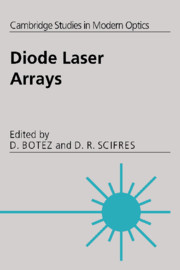Book contents
- Frontmatter
- Contents
- List of contributors
- Preface
- 1 Monolithic phase-locked semiconductor laser arrays
- 2 High-power coherent, semiconductor laser, master oscillator power amplifiers and amplifier arrays
- 3 Microoptical components applied to incoherent and coherent laser arrays
- 4 Modeling of diode laser arrays
- 5 Dynamics of coherent semiconductor laser arrays
- 6 High-average-power semiconductor laser arrays and laser array packaging with an emphasis on pumping solid state lasers
- 7 High-power diode laser arrays and their reliability
- 8 Strained layer quantum well heterostructure laser arrays
- 9 Vertical cavity surface-emitting laser arrays
- 10 Individually addressed arrays of diode lasers
- Index
7 - High-power diode laser arrays and their reliability
Published online by Cambridge University Press: 10 November 2009
- Frontmatter
- Contents
- List of contributors
- Preface
- 1 Monolithic phase-locked semiconductor laser arrays
- 2 High-power coherent, semiconductor laser, master oscillator power amplifiers and amplifier arrays
- 3 Microoptical components applied to incoherent and coherent laser arrays
- 4 Modeling of diode laser arrays
- 5 Dynamics of coherent semiconductor laser arrays
- 6 High-average-power semiconductor laser arrays and laser array packaging with an emphasis on pumping solid state lasers
- 7 High-power diode laser arrays and their reliability
- 8 Strained layer quantum well heterostructure laser arrays
- 9 Vertical cavity surface-emitting laser arrays
- 10 Individually addressed arrays of diode lasers
- Index
Summary
Introduction
Diode lasers were first demonstrated in 1962. These structures were broad area homojunction devices which could only be operated at 77 K with short (< 100 ns) pulse widths. From those early lasers, much progress has been made in increasing the output power, reliability, operating temperature and efficiency of diode lasers and diode laser arrays. For example, at present, monolithic laser diode arrays have been operated at temperatures in excess of 100°C at output power levels in excess of 100 W cw and at power conversion efficiencies of greater than 50% with multiwatt output powers. This chapter will describe the history of the improvements made in high-power diode laser research and the failure mechanisms responsible for the limitations in output power of high-power diode lasers. We also present the results of reliability testing at high output power for a variety of semiconductor laser structures and review environmental testing for laser array products. The design considerations for long life operation at high power are also presented.
7.1.1 History of high-power diode laser arrays
Following the early introduction of homojunction diode lasers, single heterostructure and double heterostructure (DH) diode lasers were demonstrated in the late 1960s. The double heterostructure laser was the first laser to exhibit cw room temperature operation This DH laser offered two major improvements over the original homojunction device.
- Type
- Chapter
- Information
- Diode Laser Arrays , pp. 294 - 335Publisher: Cambridge University PressPrint publication year: 1994
- 3
- Cited by



